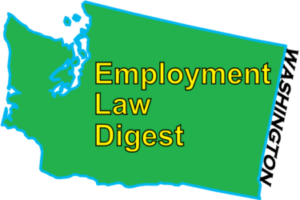This is a case summary of Davis v. West One Automotive Group, 140 Wn.App. 449 (Div. 3 2007), petition denied, 163 Wn.2d 1039 (Wash. 2008). Subjects include:
» RACE AS A PROTECTED CLASS
» HOSTILE WORK ENVIRONMENT
» DISPARATE TREATMENT
» RETALIATORY DISCHARGE
IMPORTANT: This article is for informational purposes only and is based upon my point of view. This is not a resource for the actual and complete appellate court opinion. Due to the rapidly changing nature of the law, we make no warranty or guarantee concerning the accuracy or reliability of the content in this article. No content on this site, regardless of date, should ever be used as a substitute for direct legal advice from your attorney. Please review our Disclaimer|Terms of Use|Privacy Policy before proceeding.

case summarY – 12 PRIMARY Facts:
[1] Mark Davis, an African American, was hired as a salesman for West One in February 2005 and terminated in July 2005.
[2] During the course of his five-month employment, Mr. Davis experienced racially charged comments in the workplace.
[a] On one occasion, West One manager and Mr. Davis’s supervisor, Dan Willard, asked Mr. Davis if he knew “why blacks have a day off on Martin Luther King Day?” When Mr. Davis said he did not know, Mr. Willard responded, “Because they shot and killed his black a[##].” Mr. Davis told Mr. Willard the comment was inappropriate and not to make such a comment again.
[b] Another time, Mr. Willard stated, “Blacks on the eastside, Mexicans on the west; hell I don’t know.” Mr. Davis was offended, and told Mr. Willard so.
[c] A third incident involved Mr. Willard walking by Mr. Davis’s desk, kicking it and remarking, “What’s up, bitc[#].” Mr. Davis was offended, regarding “bitc[#]” as a derogatory term some African American men use to refer to each other. Mr. Davis again told Mr. Willard he was offended.
[3] Fellow sales employee, Joe Klein, also made comments that Mr. Davis found racially offensive.
[a] On an occasion when Mr. Davis had customers in the finance office and his telephone rang, Mr. Klein stopped him from answering stating, “Hey, Buckwheat, you can’t get that call.” Mr. Davis was offended and asked Mr. Klein to refer to him by name.
[b] One day after Mr. Davis had sold a car to a woman who worked with his wife, and whose husband had previously bought a car from Mr. Klein, Mr. Klein grew angry and stated, “if you’re going to be here at West One Automotive Group, you need to do things our way.”
[c] Another time, some customers arrived to see Mr. Davis and Mr. Klein told him he had “black people” waiting for him. Mr. Davis was offended, noting he did not refer to Mr. Klein’s customers as ” white people.”
[d] Mr. Davis complained to West One Human Resources about Mr. Klein’s “Buckwheat” comment. No disciplinary action was taken.
[4] At a subsequent staff meeting, Mr. Willard discussed generally with the entire staff that, “no use of any type of insensitive name, nickname or not, would be tolerated.”
[5] Because no action had been taken against Mr. Klein and because he regarded Mr. Willard as “the worst offender of racial discrimination,” Mr. Davis did not complain again.
[6] In June 2005, Mr. Davis was salesman of the month. Per customary practice, this honor entitled him to drive any vehicle on the lot for the month, enjoy free gasoline and have his picture in the newspaper.
[7] Due to an error, Mr. Davis’s picture was not put in the paper; instead another salesman was pictured and identified as salesman of the month. When Mr. Davis discovered the error and brought it to West One’s attention, West One refused to place a corrected photo in the newspaper.
[8] As salesman of the month, Mr. Davis chose to drive a Bavarian Motor Works (BMW) vehicle, and began using it on a Saturday.
[a] On Sunday, Mr. Willard told Mr. Davis that the BMW needed to be returned for service.
[b] Mr. Davis believed this was not true and the car had already been serviced, so he drove the car home.
[c] Mr. Davis called in ill on Monday and asked to speak to Mr. Willard. When Mr. Willard did not respond to his page, he asked the receptionist to tell Mr. Willard he was sick.
[d] Approximately two days later, Mr. Davis returned to West One, driving the BMW.
[e] When he returned, he was terminated.
[9] Mr. Davis brought this action under WLAD, chapter 49.60 RCW, alleging hostile work environment, disparate treatment and retaliatory discharge. West One moved for summary judgment dismissal.
[10] In support of its motion, West One submitted two declarations of counsel, attaching various documents, extracts of Mark Davis’s deposition and declarations of Dan Willard, Joe Klein and other West One employees.
[a] West One employees stated that Mr. Davis was habitually late to work, missed shifts or left during shifts, and was reluctant to assist in tasks expected of the sales staff.
[b] With respect to the particular discriminatory statements identified by Mr. Davis, neither Mr. Willard nor Mr. Klein denied making the statements at issue.
[c] Mr. Klein explained that he did not consider “Buckwheat” to be a racially charged moniker and did not intend to offend Mr. Davis.
[c] Mr. Willard offered that his reasons for terminating Mr. Davis were his ongoing unreliability and, most importantly, his failure to return the BMW for several days despite having been asked to do so.
[11] None of the West One employee declarations addressed the issue of Mr. Davis not being recognized in the newspaper as salesman of the month. Mr. Davis stated at his deposition that he believed the error was initially a “screw-up.” Once he discovered the error and brought it to West One’s attention, he was recognized as salesman of the month, but West One refused to place his picture in the paper.
[12] The trial court granted West One’s motion for summary judgment dismissing all claims. This appeal followed.
Davis v. West One Automotive Group, 140 Wn.App. 449 (Div. 3 2007), petition denied, 163 Wn.2d 1039 (Wash. 2008) (internal citations omitted) (paragraph formatting and hyperlinks added).
ISSUE #1: Was the trial court’s summary-judgment dismissal of Plaintiff’s hostile-work-environment claim proper?

[1-1] FACTS ADDUCED ON SUMMARY JUDGMENT: “The facts as adduced on summary judgment are set forth here in a light most favorable to the non-moving party.” Davis, 163 Wn.2d at 452-53 (citing Marquis v. City of Spokane, 130 Wash.2d 97, 105, 922 P.2d 43 (1996)).
[1-2] SUMMARY JUDGMENT: The Court “review[s] orders of summary judgment dismissal de novo, engaging in the same inquiry as the trial court.” Id. at 456 (citing Korslund v. DynCorp Tri-Cities Servs., Inc., 156 Wash.2d 168, 177, 125 P.3d 119 (2005); RAP 9.12).
[1-2a] APPROPRIATE WHEN NO GENUINE ISSUES OF MATERIAL FACT AND MOVING PARTY ENTITLED TO JUDGMENT AS A MATTER OF LAW: “Summary judgment is appropriate only if the ‘pleadings, depositions, answers to interrogatories, and admissions on file, together with the affidavits, if any, show that there is no genuine issue as to any material fact and that the moving party is entitled to judgment as a matter of law.'” Id. (citing CR 56(c)).
[1-2b] COURT MUST CONSIDER FACTS AND ALL REASONABLE INERENCES FROM THOSE FACTS IN LIGHT MOST FAVORABLE TO NONMOVING PARTY: “The court must consider the facts submitted and all reasonable inferences from those facts in the light most favorable to the nonmoving party.” Id. (citing Marquis, 130 Wash.2d at 105, 922 P.2d 43; Clements v. Travelers Indem. Co., 121 Wash.2d 243, 249, 850 P.2d 1298 (1993)).
[1-2c] PURPOSE IS TO AVOID A USELESS TRIAL: “The purpose of summary judgment, after all, is to avoid a ‘useless trial.'” Id. (citing Lamon v. McDonnell Douglas Corp., 91 Wash.2d 345, 349, 588 P.2d 1346 (1979)) (internal citations and quotation marks omitted).
[1-2d] TO OVERCOME SUMMARY JUDGMENT, DISCRIMINATION-CASE PLAINTIFF’S MUST ESTABLISH SPECIFIC AND MATERIAL FACTS TO SUPPORT EACH ELEMENT OF A PRIMA FACIE CASE: “In order to overcome a motion for summary judgment, a plaintiff in a discrimination case must establish specific and material facts to support each element of a prima facie case.” Id. (citing Marquis, 130 Wash.2d at 105, 922 P.2d 43).
[1-2e] QUESTIONS OF FACT DETERMINED AS A MATTER OF LAW ONLY WHERE REASONABLE MINDS CAN REACH BUT ONE CONCLUSION: “Questions of fact can be determined as a matter of law only where reasonable minds can reach but one conclusion.” Id. (citing Sherman v. State, 128 Wash.2d 164, 184, 905 P.2d 355 (1995)).
[1-2f] IN DISCRIMINATION CASES, SUMMARY JUDGMENT IN FAVOR OF EMPLOYER IS OFTEN INAPPROPRIATE: “Summary judgment in favor of the employer in a discrimination case is often inappropriate because the evidence will generally contain reasonable but competing inferences of both discrimination and nondiscrimination that must be resolved by a jury.” Id. (citing Kuyper v. Dep’t of Wildlife, 79 Wash.App. 732, 739, 904 P.2d 793 (1995), review denied, 129 Wash.2d 1011, 917 P.2d 130 (1996)).
[1-3] HOSTILE WORK ENVIRONMENT (BASED ON RACE): “RCW 49.60.180(3) prohibits an employer from discriminating against an employee ‘in other terms or conditions of employment because of … race.'” Davis, 163 Wn.2d at 456-57 (hyperlinks added).
[1-3a] THE PRIMA FACIE CASE: “To establish a prima facie case he must show that he suffered harassment that was[:]
(1) unwelcome,
(2) because he was a member of a protected class,
(3) affected the terms and conditions of his employment, and
(4) imputable to the employer.
Id. at 457 (citing Antonius v. King County, 153 Wash.2d 256, 261, 103 P.3d 729 (2004) (citing Glasgow v. Georgia-Pac. Corp., 103 Wash.2d 401, 406-07, 693 P.2d 708 (1985); see also Clarke v. Office of Attorney Gen., 133 Wash.App. 767, 785, 138 P.3d 144 (2006), review denied, 160 Wash.2d 1006, 158 P.3d 614 (2007)) (paragraph formatting added).
[1-3b] FIRST ELEMENT (UNWELCOME): “Conduct is unwelcome if the plaintiff did not solicit or incite it.” Id. (citing Glasgow, 103 Wash.2d at 406, 693 P.2d 708).
[1-3c] THIRD ELEMENT (TERMS AND CONDITIONS OF EMPLOYMENT): “The third element requires that the harassment be sufficiently pervasive as to alter the conditions of employment and create an abusive working environment.” Id. (citing Glasgow, 103 Wash.2d at 406, 693 P.2d 708). “Whether the comments here affected the conditions of Mr. Davis’s employment is a question of fact.” Id.
Totality of the Circumstances Test: “To determine whether West One’s conduct was sufficiently pervasive so as to alter the conditions of employment and create an abusive working environment, we look at the totality of the circumstances.” Id. (citing Adams v. Able Bldg. Supply, Inc., 114 Wash.App. 291, 296, 57 P.3d 280 (2002)).
[1-3e] FOURTH ELEMENT (IMPUTABLE TO EMPLOYER): “To establish the fourth element Mr. Davis must show West One knew or should have known of the comments and failed to take reasonable corrective action to end the harassment.” Id. at 458 (citing Francom v. Costco Wholesale Corp., 98 Wash.App. 845, 853-54, 991 P.2d 1182, review denied, 141 Wash.2d 1017, 10 P.3d 1071 (2000); Campbell v. State, 129 Wash.App. 10, 20, 118 P.3d 888 (2005), review denied, 157 Wash.2d 1002, 136 P.3d 758 (2006)).

[1-4] FIRST AND SECOND ELEMENTS (UNWELCOME and MEMBER OF PROTECTED CLASS, RESPECTIVELY): In this case, the Court initially determined as follows: “The record on summary judgment provides ample evidence to sustain the first and second elements.” Davis, 163 Wn.2d at 457. It based its finding on the following:
» “Mr. Davis testified at deposition and by affidavit that he was subjected to racially derogatory comments, which he did not welcome and which he found offensive.” Id. West One argued “that certain comments … were not racially motivated.” See id.
∴ Court’s Analysis: “While West One argues that certain comments, however offensive to Mr. Davis, were not racially motivated, this cannot be determined as a matter of law.” Id.
“Reasonable minds could find that Mr. Willard’s statements regarding Dr. Martin Luther King, Jr. were racially charged, and not merely ‘odd’ as West One suggests.” Id.
» “A jury could also find that calling an African American man a ‘bitc[#]’ has racial overtones, as understood by Mr. Davis.” Id. Thus, the Court “reject[ed] West One’s invitation to take ‘judicial notice’ that such a term has no racial connotation, but is invariably a gender-based term.” Id. (internal citation omitted).
[1-5] THIRD ELEMENT (TERMS AND CONDITIONS OF EMPLOYMENT): In this case, the Court initially determined as follows: “Whether the comments here affected the conditions of Mr. Davis’s employment is a question of fact.” Id. Thereafter, the Court found facts showing that the harassment was sufficiently pervasive as to alter the conditions of employment and create an abusive working environment, as follows:
» “Mr. Davis asserts he was humiliated by these comments. He claims emotional distress.” Id.
» “The record shows Mr. Davis was often late and absent from work.” Id.
» “There was friction between him and other employees.” Id.
» “When he called in ill a few days before his termination, Mr. Davis testified that he was ‘[p]robably mentally sick, drained.'” Id. at 457-58 (alteration in original).
∴ Court’s Analysis: Based upon the foregoing, the Court concluded as follows: “An inference could be drawn that this was the result of the hostile work environment.” Id. at 458.
[1-5a] TOTALITY OF THE CIRCUMSTANCES
∴ Court’s Analysis: Next, the Court applied the Totality-of-the-Circumstances Test and concluded as follows: “Looking at all the evidence in the light most favorable to Mr. Davis, as required, we conclude he had raised a question of fact with regard to the third element of this claim.” Id.
[1-6] FOURTH ELEMENT (IMPUTABLE TO EMPLOYER): In this case, the Court both identified facts showing that West One knew or should have known of the subject comments and it considered facts regarding whether West One took reasonably corrective action to end the harassment, as follows:
» “Mr. Davis reported the ‘Buckwheat’ comment by Mr. Klein.” Id.
∴ Court’s Analysis: Mr. Davis “was not required to report the comments by Mr. Willard, as Mr. Willard was his supervisor.” Id.
» “The comments occurred openly in the work place.” Id.
» “West One did respond to the one comment Mr. Davis reported by telling all staff during a general staff meeting that use of insensitive names would not be tolerated.”
∴ Court’s Analysis: “Whether this was sufficient to end the harassment is a question of fact.” Id. (internal citations omitted).

[1-7] NUMEROUS FACTUAL ISSUES SURROUND THE HOSTILE WORK ENVIRONMENT CLAIM — SUMMARY JUDGMENT DISMISSAL REVERSED: In this case, the Court held as follows: “Given the numerous factual issues surrounding Mr. Davis’s hostile work environment claim, we reverse the superior court’s order granting summary judgment dismissal.” Id. at 458.
.
ISSUE #2: Was the trial court’s summary-judgment dismissal of Plaintiff’s disparate treatment claim proper?

[2-1] DISPARATE TREATMENT — THE PRIMA FACIE CASE: “To establish a prima facie case of racial discrimination based on disparate treatment, an employee must show that[:]
(1) the employee belongs to a protected class;
(2) the employer treated the employee less favorably in the terms or conditions of employment
(3) than a similarly situated, nonprotected employee,
(4) who does substantially the same work.
Davis, 163 Wn.2d at 459 (citing Washington v. Boeing Co., 105 Wash.App. 1, 13, 19 P.3d 1041 (2000)) (internal citation omitted) (paragraph formatting added).

“Mr. Davis … claims the court erred in dismissing his claim of disparate treatment.” Id. at 458.
[2-2] MATERIAL ALLEGATIONS OF DISPARATE TREATMENT: THERE ARE DISPUTED ISSUES OF FACT FOR THE JURY: In this case, “Mr. Davis alleges three specific instances of disparate treatment.” Id. at 459.
SPECIFIC INSTANCE #1 — THE PICTURE:
» “First … [Mr. Davis] claims his picture was not put in the paper when he was salesman of the month, as was custom.” Id.
» “West One claims this was a mistake.” Id.
» “Mr. Davis testified that when he brought the mistake to West One’s attention, it refused to correct the error by placing his picture in the paper.” Id.
∴ Court’s Analysis: “Whether West One’s actions were a mere mistake or support a claim of disparate treatment is a disputed question of fact.” Id.
SPECIFIC INSTANCE #2 — THE CAR:
» “Mr. Davis next alleges he was treated less favorably than other similarly situated employees because he was not permitted to drive any car he wanted as salesman of the month, though Mr. Klein was always permitted to do so.” Id.
» “When Mr. Davis was salesman of the month, he elected to drive a BMW. When he took the BMW, he was told to return it for service.” Id.
∴ Court’s Analysis: “There is a factual dispute about whether service was necessary. This dispute presents a question of fact for a jury.”
SPECIFIC INSTANCE #3 — THE HARSHER DISCIPLINE:
» “Mr. Davis claims he was held to a higher standard than other employees; he was disciplined more harshly for missing work and being late than were his co-workers.” Id.
» “West One disputes this claim.” Id.
∴ Court’s Analysis: “There is conflicting evidence as to the tardiness and truancy of Mr. Davis and other employees, and as to West One’s tolerance, or not, of this behavior.”

[2-5] DISPARATE TREATMENT: SUMMARY JUDGMENT DISMISSAL WAS INAPPRORIATE — REVERSED: “On this record summary judgment was not appropriate. We reverse the superior court’s order granting summary judgment dismissal of Mr. Davis’s disparate treatment claim.” Id. at 459.
ISSUE #3: Was the trial court’s summary-judgment dismissal of Plaintiff’s retaliatory-discharge claim proper?

[3-1] RETALIATORY DISCHARGE (GENERALLY): “It is an unfair practice for any employer … to discharge, expel, or otherwise discriminate against any person because he or she has opposed any practices forbidden by this chapter.” Davis, 163 Wn.2d at 460 (citing Kahn v. Salerno, 90 Wash.App. 110, 128, 951 P.2d 321 (quoting RCW 49.60.210(1)), review denied, 136 Wash.2d 1016, 966 P.2d 1277 (1998)). “An employer need only be motivated in part by retaliatory influences when discharging an employee engaged in protected activity to violate the statute.” Id. (internal citation omitted).
[3-1a] THE PRIMA FACIE CASE: “In order to establish a prima facie case of retaliatory discharge, Mr. Davis must show
(1) he engaged in a statutorily protected activity;
(2) he was discharged or had some adverse employment action taken against him; and
(3) retaliation was a substantial motive behind the adverse employment action.
Id. (citing Campbell v. State, 129 Wash.App. 10, 22-23, 118 P.3d 888 (2005), review denied, 157 Wash.2d 1002, 136 P.3d 758 (2006)).
[3-2] BURDEN-SHIFTING FRAMEWORK (GENERALLY): “Because Mr. Davis established a prima facie case of retaliation, the burden shifted to West One to present admissible evidence of its legitimate reason for the discharge.” Id. at 460 (citing Renz v. Spokane Eye Clinic, P.S., 114 Wash.App. 611, 618, 60 P.3d 106 (2002)).

“Mr. Davis argues the court erred in dismissing his retaliation claim.” Davis, 163 Wn.2d at 460.
[3-3] RETALIATORY DISCHARGE: DAVIS ESTABLISHES A PRIMA FACIE CASE: “Mr. Davis claims he was fired for reporting the hostile work environment.”
∴ Court’s Analysis (Elements #1, #2): In this case, the Court found that “[t]his is a protected activity covered by statute and his termination qualifies as an adverse employment action.” Id. at 460 (citing Campbell v. State, 129 Wash.App. 10, 22, 118 P.3d 888 (2005), review denied, 157 Wash.2d 1002, 136 P.3d 758 (2006)).
∴ Court’s Analysis (Element #3): With regard to element #3 (retaliation was a substantial motive behind the adverse employment action), the Court found as follows: “It is unclear if retaliation was a substantial motive behind the termination. The evidence presented at summary judgment would support a finding either way on the causation issue. This is a jury question.” Id. at 460.
[3-4] BURDEN-SHIFTING FRAMEWORK (GENERALLY): EMPLOYER PRESENTED EVIDENCE OF LEGITIMATE BASIS FOR DISCHARGE: DAVIS SHOWED PRETEXT: In this case, the Court determined the following facts:
» “West One presented testimony that it terminated Mr. Davis because he refused to return the BMW as requested.” Id.
» “Mr. Davis admitted he knew West One had asked he return the vehicle, but that he kept the car for several days and believed West One’s explanation that the car needed service was false.” Id.
» He was terminated immediately upon returning to work with the vehicle. Id. at 460-61.
» Neither party offers any evidence of service records. Id. at 461.
∴ Court’s Analysis: The Court implicitly determined that Defendant West One presented admissible evidence of its legitimate reason for the discharge. See id. at 461. Accordingly, the Court found that Davis presented facts raising “a genuine issue of material fact showing West One’s proffered reason for his termination was a pretext” for discrimination. EDITOR’S NOTE: the plaintiff’s duty to establish pretext is the third an final step of the McDonnel Douglas Burden-Shifting Framework. See id.

[3-5] DAVIS RAISED GENUINE ISSUES OF MATERIAL FACT REGARDING PRETEXT — SUMMARY JUDGMENT DISMISSAL OF THE RETALIATION CLAIM WAS INAPPROPRIATE: The Court concluded as follows: “Viewing the evidence in a light most favorable to Mr. Davis, as we must on summary judgment, we conclude that Mr. Davis has presented facts that raise a genuine issue of material fact whether West One’s proffered reason for his termination was a pretext.” Id. at 461 (citing Renz, 114 Wash.App. at 619, 60 P.3d 106).
“Summary judgment dismissal of Mr. Davis’s retaliation claim was not appropriate.” Id.
NOTABLES & IMPLICATIONS:
OVERCOMING SUMMARY JUDGMENT IN DISCRIMINATION CASES
(1) “In order to overcome a motion for summary judgment, a plaintiff in a discrimination case must establish specific and material facts to support each element of a prima facie case.” Id. (citing Marquis, 130 Wash.2d at 105, 922 P.2d 43).
LEARN MORE
If you would like to learn more, consider contacting an experienced employment discrimination attorney to discuss your case. This article is not offered as legal advice and will not establish an attorney-client relationship with Washington Employment Law Digest or the author of this article. By reading this article, you agree to our Disclaimer / Terms-of-Use / Privacy Policy.




